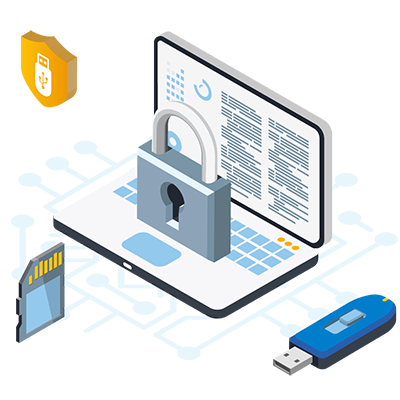IMPORTANCE OF DEPLOYING ENDPOINT DLP
Every company's data is a valuable asset, and safeguarding it from loss, leakage, or theft is critical in all scenarios. Organizations can protect sensitive data regardless of endpoint location by installing an endpoint DLP solution.
This is installed on each endpoint device, allowing for content discovery, data leakage prevention through storage devices, and data protection while a device is outside the corporate network.
Endpoint DLP ensures that unauthorized users do not have the chance to compromise sensitive files. This software categorizes confidential business data and determines if it violates any policies set by the organization or a regulatory compliance (HIPAA, PCI-DSS, or GDPR).
After identifying these violations, Endpoint DLP implements different tools and processes to resolve an incident. This comes in the form of encryption, notifications, and other defensive actions to hold off end users from accidentally or intentionally sharing data, which could put the organization's safety in jeopardy.
Endpoint DLP tracks and manages endpoint activities, filters data on networks, and keeps an eye on data in the cloud. It also ensures to comply with regulations and determine areas of vulnerabilities for forensics and incident response.

3 CORE USES OF ENDPOINT DLP
Data loss prevention has three key objectives:
Protect Personal Information
If your organization gathers and keeps Personally Identifiable Information (PII), Protected Health Information (PHI), or Payment Card Information (PCI), you need to follow certain rules.
There are different compliance regulations, depending on the industry you belong to. For instance, there's HIPAA for health and GDPR for personal data of people residing in the European Union.
With endpoint DLP, activities and events surrounding sensitive data are monitored. It also has reporting capabilities that can organize information necessary for compliance audits.
Intellectual Property Protection
Do you have valuable intellectual property or trade secrets that, if lost or stolen, could endanger your company's financial health and brand image? Endpoint DLP solutions can categorize intellectual property in both structured and unstructured forms using context-based classification. You can prevent unwanted data exfiltration by putting policies and controls in place.
Data Visibility
An endpoint DLP solution with broad features can give you a clearer view about how individual users within your organization work with data.
How Endpoint DLP Benefits Remote Work?
Businesses shifting to remote work are looking for tools that will help them transition smoothly. One of which is the endpoint DLP. Let's discuss how this software supports remote staff when dealing with the multiple challenges they face, especially in cybersecurity.
1. Secure mobility Endpoint DLPs allows you to observe and control sensitive data, preventing it from leaving the endpoint. These techniques can stop the creation of unauthorized copies and transmissions of data in both physical and virtual contexts. Network DLPs can only protect data when computers are physically connected to the company network. Meanwhile, when you implement data protection policies at the endpoint level, it can safeguard data regardless of its location - even if they're not connected to the internet. Companies can leverage an endpoint DLP to track data flow to unauthorized individuals or applications.
2. Data flow control You can prevent data from leaking from its earliest stage using endpoint DLP. It can thwart deliberate or accidental transfers of data from the local desktop. Endpoint DLP can inspect and analyze data in motion or those stored on a managed endpoint device. It provides a detailed approach when controlling sensitive information. By thoroughly inspecting endpoints, companies can protect data containing health or financial information. It also does contextual detection, which can restrict or allow data flows based on file type, file size, related regular expressions, etc. Moreover, Endpoint DLP solutions enable enterprises to manage endpoint data exchanges with printers and other removable devices.
3. Enhanced data visibility With an endpoint DLP solution, companies can access and take control of confidential data stored across their IT system. Scanning data on endpoints outside and inside the corporate network, it discovers sensitive content and performs counteractive measures to prevent data breaches proactively.
Xcitium Endpoint DLP
If you're uncertain how to secure sensitive data and ensure regulatory compliance while your employees work from home, our simple endpoint DLP solution can help.
Xcitium can fill in the gaps in your data protection strategy. It collects and records occurrences at the system, user, and data level and provides responses on issues based on different factors. By logging all actions and executing automatic blocking, it prevents data loss at your endpoint.
Contact us now to learn more about our security offerings!
